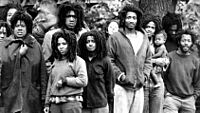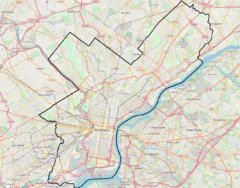MOVE (Philadelphia organization) facts for kids
Quick facts for kids MOVE |
|
|---|---|

A photo of members of the MOVE family in the 1980's
|
|
| Leader(s) | John Africa Ramona Africa (as Spokesperson) |
| Foundation | 1972 |
| Country | United States |
| Active regions | Philadelphia |
| Ideology |
|
| Status | Active |
MOVE (pronounced like the word "move") is a group that believes in living close to nature. They were founded in 1972 in Philadelphia, Pennsylvania, United States, by John Africa (born Vincent Leaphart). The name MOVE is not an acronym; it's just the word "move."
The group lived together in a communal way in West Philadelphia. They followed ideas of anarcho-primitivism, which means they wanted to live more simply, like people did before modern technology. MOVE combined ideas about social change, similar to the Black Panthers, with working for animal rights.
MOVE is known for two big conflicts with the Philadelphia Police Department (PPD). In 1978, a standoff led to the death of a police officer. Several members of MOVE were sent to prison. In 1985, another conflict happened. A police helicopter dropped bombs onto the MOVE house. This fire killed eleven people, including five children. It also destroyed 65 houses nearby.
Many people criticized the police bombing. Survivors of MOVE later sued the City of Philadelphia and the PPD. They received $1.5 million in a settlement in 1996. Other people whose homes were destroyed also sued the city. In 2005, they were awarded $12.83 million.
Contents
What is MOVE?
The group's name, MOVE, means what they intend to do. Members believe that "Everything that's alive moves." They say that if something doesn't move, it's "stagnant, dead." When members greet each other, they say "on the MOVE."
John Africa started the group in 1972. He didn't read or write well, so he told his ideas to Donald Glassey, a social worker. These ideas became "The Guidelines" for his communal group. John Africa and his followers, mostly African-American, wore their hair in dreadlocks. This style was popular with Rastafari. MOVE supported a strong form of green politics. They wanted to return to a hunter-gatherer way of life. They were against science, medicine, and technology.
MOVE members see themselves as very religious and believe in protecting all life. They think all living beings are connected. So, their lives should be treated as equally important. They seek justice that is fair for all living creatures. Following John Africa, his followers changed their last names to Africa. This showed respect for what they saw as their mother continent.
A journalist described their views as "a strange mix of black power and flower power." The group combined the ideas of the Black Panthers with the nature-loving ways of 1960s hippies. They were like "black liberationists-cum-eco warriors." MOVE also worked as an animal rights group. A member, Janine Africa, wrote from prison: "We demonstrated against puppy mills, zoos, circuses, any form of enslavement of animals. We demonstrated against Three Mile Island and industrial pollution. We demonstrated against police brutality."
John Africa and his followers lived together in a house in Powelton Village. They held protests against things they didn't like, such as zoos. Law enforcement watched MOVE's activities closely. This was especially true under Mayor Frank Rizzo, who was tough on activist groups.
In 1977, three MOVE members were jailed for causing trouble. This led to more tension and protests from the group.
The 1978 Standoff
In 1977, police said they got a court order for MOVE to leave their house. This was because neighbors had complained. MOVE members agreed to leave and give up their weapons. In return, they wanted police to release MOVE members held in jail.
Almost a year later, on August 8, 1978, police faced a standoff with MOVE members. These members had not left the house. When police tried to enter, a gunfight started. Officer James J. Ramp was killed. Sixteen other police officers and firefighters were also hurt. MOVE members said Officer Ramp was killed by police fire, not by them. Prosecutors said MOVE members fired the fatal shot. Nine MOVE members were charged with his death.
Eyewitnesses said the shot might have come from the opposite direction. This raised questions about how Officer Ramp died. MOVE members still say they had no working guns at the time. The standoff lasted about an hour before MOVE members began to surrender.
The MOVE 9
The nine MOVE members charged with Officer Ramp's death became known as the MOVE 9. Each was sentenced to up to 100 years in prison. Their names were Chuck, Delbert, Eddie, Janet, Janine, Merle, Michael, Phil, and Debbie Sims Africa.
Merle Africa died in prison in 1998. Phil Africa died in prison in 2015.
Debbie Sims Africa was the first of the MOVE 9 to be released. She was paroled on June 16, 2018. She was 22 when she was sent to prison. She gave birth to her son, Michael Davis Africa, Jr., a month after being jailed. He was taken from her a week later. Her release brought attention to other activists still in prison from the 1960s and 1970s.
Michael Davis Africa, Debbie's husband, was released on parole in October 2018. In May 2019, Janine and Janet Africa were paroled after 41 years. Eddie Goodman Africa was released in June 2019. Delbert Orr Africa was paroled in January 2020. Chuck Sims Africa, the last of the MOVE 9, was released in February 2020. Both Delbert and Chuck later died from cancer.
The 1985 Bombing
In 1981, MOVE moved to a house at 6221 Osage Avenue in West Philadelphia. Neighbors complained for years about trash around their building. They also complained about loud, sometimes rude, messages from MOVE members using a bullhorn. The bullhorn had been broken for three weeks before the bombing.
In 1985, police got arrest warrants for four MOVE members. These warrants were for things like breaking parole rules and having illegal guns. Mayor Wilson Goode and police commissioner Gregore J. Sambor called MOVE a terrorist group. Police moved neighbors out of the area before they took action. Residents were told they could return home in 24 hours.
On May 13, 1985, nearly 500 police officers arrived. They tried to clear the building and arrest the members. Nearby houses were emptied. Water and electricity were cut off to force MOVE members out. Commissioner Sambor read a speech to MOVE members. He said, "Attention MOVE: This is America. You have to abide by the laws of the United States."
The 13 MOVE members inside (seven adults and six children) did not respond. Police decided to remove them by force. An armed standoff began. Police threw tear gas into the building. MOVE members fired back. A 90-minute gunfight followed. Police fired over ten thousand rounds of ammunition. Then, Commissioner Sambor ordered the house to be bombed.
From a police helicopter, Lt. Frank Powell dropped two bombs onto the roof. These bombs were made of explosives. The fire that started killed eleven people inside the house. These included John Africa, five other adults, and five children aged 7 to 13. The fire spread and destroyed about 65 nearby houses. Firefighters had wet the building earlier. But after the fire started, officials held them back. They said they feared MOVE would shoot at the firefighters.
Ramona Africa, one of two MOVE survivors from the house, said police shot at those trying to escape.
Aftermath of the Bombing
Mayor Goode set up a group called the Philadelphia Special Investigation Commission (PSIC). This group looked into the bombing. The PSIC said that "Dropping a bomb on an occupied row house was unconscionable." After the report, Mayor Goode publicly apologized. No one from the city government was charged with a crime. Ramona Africa, the only adult MOVE survivor, was charged and convicted. She served seven years in prison.
In 1996, a jury ordered the city to pay $1.5 million to Ramona Africa and relatives of two people killed. The jury found that the city used too much force. They also said the city violated the members' rights against unfair searches. In 1985, Philadelphia was called "The City that Bombed Itself."
In 2005, a judge oversaw a trial for residents whose homes were destroyed. A jury awarded them $12.83 million from the City of Philadelphia.
In November 2020, the City Council of Philadelphia apologized for the events of May 13, 1985. The council also created an annual day to remember the MOVE Bombing.
Current Activities
Ramona Africa now speaks for the MOVE group. Mumia Abu-Jamal, a journalist who supported MOVE, was convicted of a separate murder in 1981. MOVE continues to ask for his release from prison.
Michael Moses Ward, known as Birdie Africa, was the only child to survive the 1985 bombing. He was 13 years old and suffered serious burns. His mother died in the fire. Michael lived with his father afterward and was not involved with MOVE. He died in 2013 from accidental drowning.
In April 2021, the Penn Museum and the University of Pennsylvania apologized. They had allowed human remains from the MOVE house to be used for research and training. In 1985, the city medical examiner gave bones from the MOVE house to the museum. These were to confirm if they belonged to 14-year-old Tree Africa and 12-year-old Delisha Africa. The remains were kept in a box for decades. They were studied by professors and used in an online course. One professor reportedly took the remains with him when he moved universities.
Philadelphia Health Commissioner Thomas Farley resigned in May 2021. This was because he ordered some victims' remains to be cremated. He did this without telling or getting permission from the families. The day after he resigned, the remains were found in a box labeled MOVE.
Legacy
On the 25th anniversary of the 1985 bombing, The Philadelphia Inquirer published a detailed website. It included articles, videos, interviews, and photos.
John Edgar Wideman's 1990 novel Philadelphia Fire is based on the MOVE bombing.
Mischief Brew’s 2006 song Save A City… is about the MOVE bombing.
Documentaries
The Bombing of Osage Avenue (1986) by Toni Cade Bambara and Louis Massiah explains the bombing. It shows the history of the community and how the bombing affected residents.
Let the Fire Burn (2013) by Jason Osder uses old video footage to tell the story of MOVE.
Recorder: The Marion Stokes Project (2019) also showed footage of the group.
40 Years a Prisoner (2020) by Tommy Oliver tells the story of the 1978 police raid. It also covers Mike Africa Jr.'s fight to free his parents.
Images for kids
See also
 In Spanish: MOVE para niños
In Spanish: MOVE para niños



